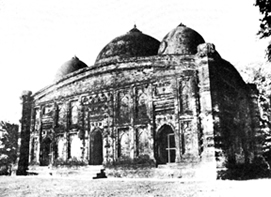Austagram Mosque
Austagram Mosque a five-domed structure, widely known as Qutb Shah's Mosque, is located in the Bhati region of present Kishoreganj district. Restored and repaired by the Department of Archaeology, Bangladesh, the mosque has now been given a better look. It is a brick-built oblong structure measuring 13.72m by 7.62m on the outside.
The four exterior angles of the building are strengthened by octagonal towers, which rise up to the roof level. The curvature of the battlements and cornices are over-emphasised. The eastern facade is pierced with three two-centred pointed archways, while the south and north walls each has two similar arched-doorways. Inside, the western wall accommodates three semi-circular mihrabs, of which the central one is bigger and shows a rectangular projection outside having round pinnacles on its angles.

The interior of the mosque, a single oblong hall of 10.97m by 4.88m, has been very cleverly divided into five square bays - a large one in the centre and a pair of smaller ones on either side. The architect had first marked off the central square bay by erecting two wide transverse arches from the top of the engaged brick pillars on the west and east walls and covered it with a large hemispherical dome on Bengali pendentives. Then each of the flanking rectangular bays were then divided into two equal square portions by inserting an additional arch between the east-west transverse arches and the side walls. These small square bays are covered with small bubble-shaped domes, which are carried on the usual Sultanate Bengali pendentives. The building has therefore a total of five domes - a large one in the centre and two smaller ones on either side of the central dome.
The mosque was originally decorated with terracotta ornamentation, traces of which are still visible in the mihrab niches, and the outer facades. The exterior facades are decorated with rectangular panels between the doorways. The panels are arranged perpendicularly, one above the other. Each of these panels has a cusped arch motif, and shows varieties of terracotta designs. Similar panels are also noticed on the facets of the corner towers, which are divided into sections by beautiful mouldings. All the doorways are contained within rectangular frames. The spandrels of doorway arches are ornamented with scroll-works with rosettes, while above are tiers of mouldings.
The mosque is not dated by inscription. Local legends ascribe the building to the saint Qutb Shah, whose tomb is nearby. But at what time the saint flourished here and constructed the mosque is not known.
However, the constructional and decorative aspects of the building, such as the curved cornice, the semi-circular mihrab niches, the two centred pointed arches, the corner towers rising up to the roof level, terracotta ornamentation and the panel decorative designs on the outer surface of the walls, suggest that it is a product of the Sultanate period and may be dated approximately in the second half of the 16th century.
An important aspect of the building is that it marks the beginning of a unique variety of five-domed mosques in Bengal. Unlike the tenga iswaripur mosque (c early 17th century) at Iswaripur in Sathkhira and the kartalab khan’s mosque (1700-04) at Dhaka, where five domes are in the same line, the present example shows a large dome in the centre and four small ones on the four corners. The type gradually evolved in the land, as we can see from the sarail hatkhola mosque (1663) in Brahmanbaria and the walipur alamgiri mosque (1692) in Chandpur. It may be suggested that such a mosque design in Bengal was derived from the five-domed Jamat Khana Mosque (c 1310-16) at the dargah of Nizamuddin Aulia in Delhi. [MA Bari]
